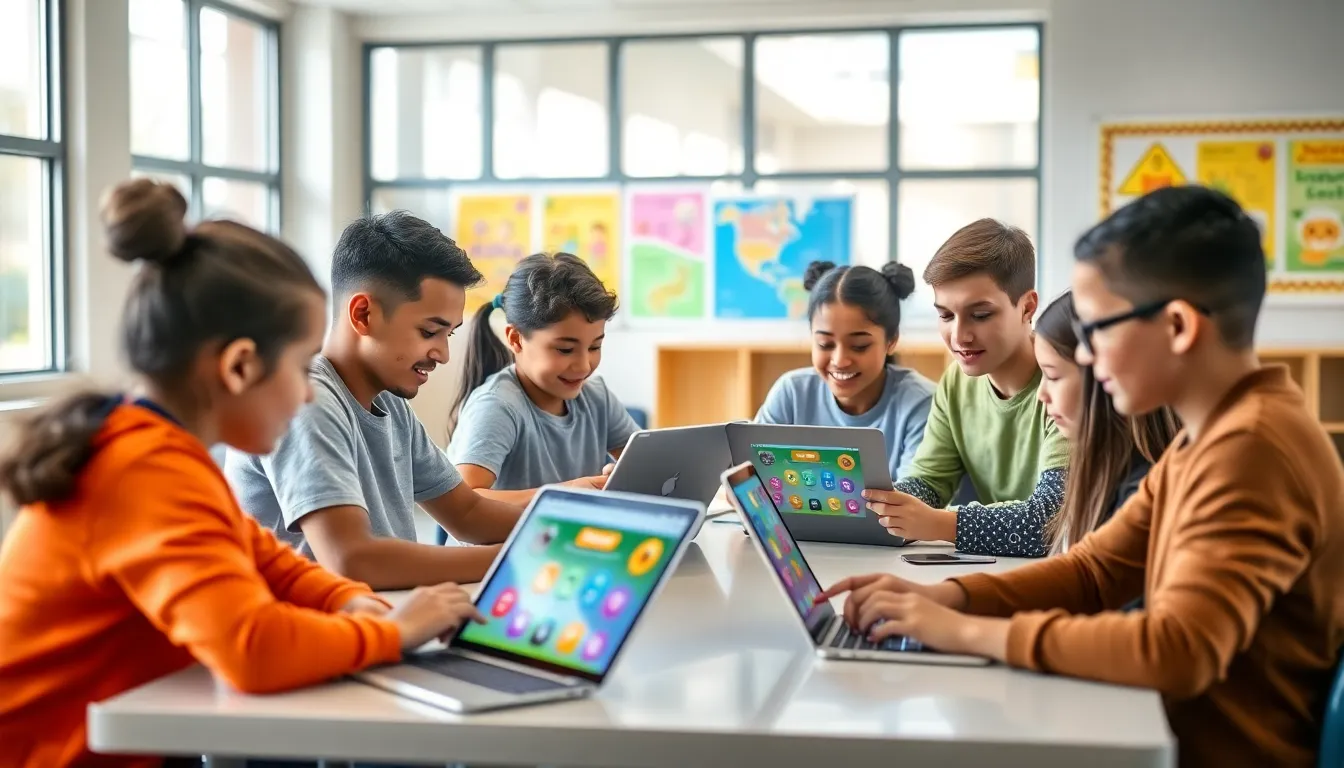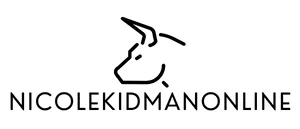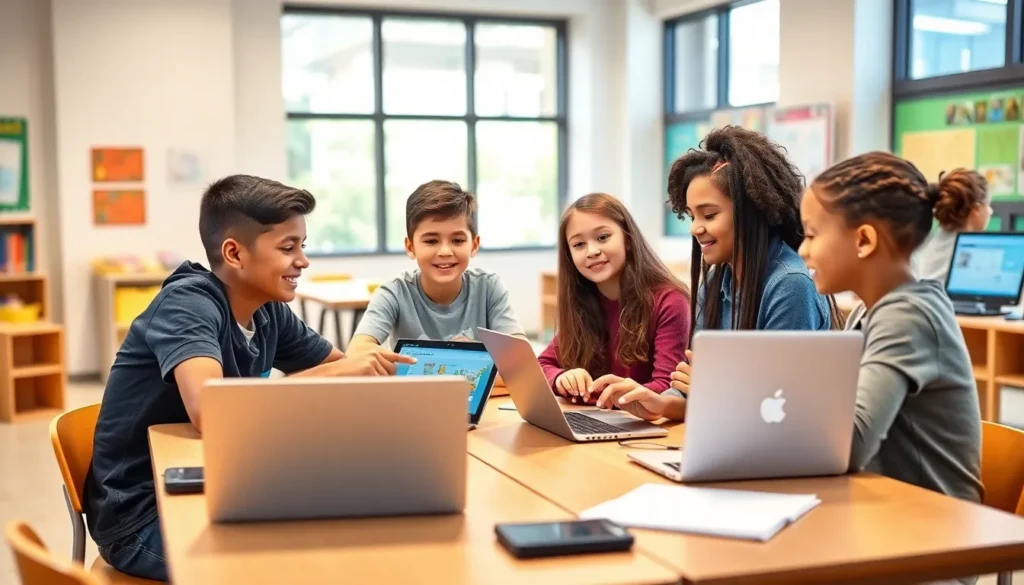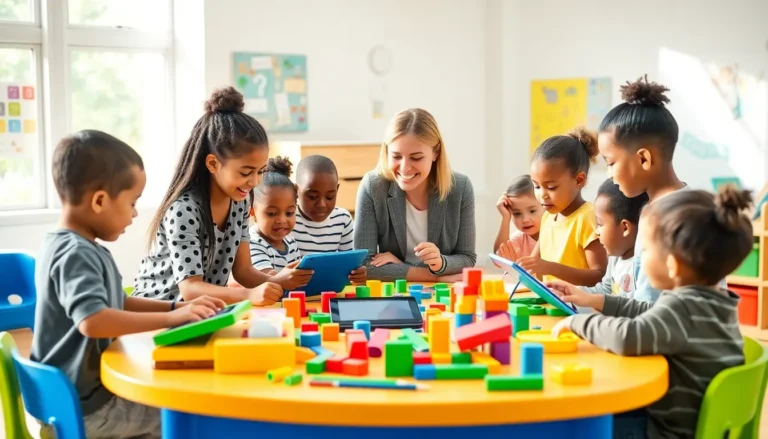Table of Contents
ToggleIn a world where technology reigns supreme, digital classrooms are transforming the way students learn. Imagine trading in dusty textbooks for interactive screens and swapping traditional lectures for engaging multimedia presentations. It’s not just a trend; it’s a revolution in education that promises to make learning as exciting as binge-watching the latest series on your favorite streaming platform.
Overview of Digital Classrooms
Digital classrooms incorporate various technologies to enhance educational experiences. Instead of relying solely on traditional methods, educators utilize multimedia tools, online resources, and interactive platforms. This shift allows for more engaging content delivery tailored to diverse learning styles.
Students access a wealth of information through digital platforms like Google Classroom and Microsoft Teams. Real-time communication fosters collaboration among peers and instructors, making learning more interactive. Educators can track student progress using analytics tools, enhancing personalized instruction.
Resources such as educational apps and virtual simulations add depth to the curriculum. They provide hands-on experiences that traditional classrooms often lack. Digital assessments offer immediate feedback, enabling students to understand their strengths and areas for improvement swiftly.
Flexible learning environments also emerge from digital classrooms. Learners can engage in lessons anytime and anywhere, accommodating various schedules. This flexibility supports both synchronous and asynchronous learning, allowing students to participate according to their timelines.
The integration of gamification further motivates learners by adding game-like elements to educational activities. Competitions and rewards encourage participation and make learning enjoyable. Schools increasingly leverage these strategies to create stimulating environments.
Finally, digital classrooms prepare students for the future. By utilizing technology, students develop essential skills such as digital literacy and critical thinking. Preparing them for today’s workforce remains a primary goal of modern education.
Benefits of Digital Classrooms

Digital classrooms offer numerous advantages that enhance the educational landscape. Students benefit from interactive technologies that make learning more accessible and engaging.
Enhanced Learning Experience
Digital classrooms provide various multimedia tools and resources. Interactive presentations, videos, and educational apps offer students diverse ways to absorb information. The ability to customize learning pathways allows for an individualized approach. For example, students can revisit lectures through recorded sessions, ensuring they understand complex concepts. Educational games and virtual simulations contribute to practical learning experiences. These features cater to different learning styles, fostering better retention of knowledge.
Increased Engagement
Engagement levels soar in digital classrooms due to the dynamic learning environment. Interactive platforms encourage participation through discussions, polls, and collaborative projects. Gamified elements, such as leaderboards and rewards, motivate students to excel. Real-time feedback keeps learners informed about their progress. Furthermore, accessible resources enable students to conduct research and participate in forums outside the classroom. The convenience of learning anytime and anywhere allows students to remain focused and interested in their studies. Each of these factors contributes to a richer educational experience, promoting a passion for learning.
Challenges of Digital Classrooms
Digital classrooms face several challenges that can hinder their effectiveness.
Technical Limitations
Accessing technology poses a significant barrier for some students. Issues such as unreliable internet connections or outdated devices can disrupt learning experiences. Many schools lack the necessary infrastructure to support advanced digital tools. Educators often encounter compatibility problems between various platforms and software. Limited technical support may add further complications, leaving teachers unprepared for troubleshooting. Consequently, these technical limitations can result in unequal learning opportunities among students.
Teacher Training
Effective implementation of digital classrooms requires comprehensive teacher training. Many educators lack familiarity with the latest technology and digital teaching methods. Professional development programs often fall short in addressing the specific needs of teachers. Without adequate training, educators struggle to use digital tools effectively. The ability to create engaging and interactive lessons hinges on teachers’ skills and confidence in using technology. A lack of ongoing support can exacerbate these challenges, diminishing teachers’ capacity to adapt to new educational environments.
Tools and Technologies for Digital Classrooms
Digital classrooms leverage various tools and technologies to enhance learning experiences. Incorporating these resources fosters engagement and collaboration among students and educators.
Learning Management Systems
Learning Management Systems (LMS) serve as centralized platforms for educational content. Google Classroom and Microsoft Teams exemplify popular LMS that enable real-time communication and assignment tracking. Teachers can upload materials such as videos, documents, and resources to streamline course delivery. Student performance analytics within these systems provide insights into progress, allowing for personalized learning paths. Efficient use of LMS facilitates classroom organization, giving students easy access to their assignments and feedback. These systems increase accountability, making students more responsible for their learning journey.
Interactive Tools
Interactive tools enrich the educational experience by encouraging participation. Platforms like Kahoot and Nearpod allow educators to create quizzes and engaging presentations that promote active learning. Students respond to questions and participate in discussions through their devices, fostering collaboration in a dynamic environment. Whiteboard applications enable brainstorming sessions that encourage creativity and teamwork. Utilizing virtual simulations provides hands-on experiences not found in traditional classrooms. These tools captivate students’ attention while enhancing retention, thus transforming how lessons are delivered and experienced.
Future of Digital Classrooms
Digital classrooms are set to evolve rapidly in response to emerging technologies and innovative teaching methods. Artificial intelligence plays a crucial role in personalizing learning experiences, adapting content to fit individual student needs. Virtual and augmented reality technologies offer immersive learning experiences that bring subjects to life, allowing students to explore complex concepts in engaging ways.
The widespread adoption of 5G technology significantly enhances the capabilities of digital classrooms. Increased internet speeds enable seamless access to high-quality multimedia content, fostering collaborative projects and interactive simulations. Moreover, enhanced security protocols ensure that student data remains protected in this digital landscape.
Global collaboration among students and educators will likely become more commonplace. Platforms that promote cross-border communication allow learners from different cultures to work together, enriching their understanding of diverse perspectives. This interconnectedness fosters essential skills, such as teamwork and communication.
Education equity will gain importance as stakeholders strive to bridge the digital divide. Investments in infrastructure and technological resources can improve access for underserved communities, ensuring all students benefit from digital learning environments. Schools will prioritize inclusive technologies that cater to diverse learning abilities and styles.
Professional development for teachers will focus on building expertise in using advanced digital tools effectively. Ongoing training and mentorship opportunities will help educators stay current with technological trends. Engaged and well-prepared educators significantly enhance the effectiveness of digital classrooms and positively impact student success.
The future of digital classrooms promises a more personalized, collaborative, and equitable educational experience. Implementing cutting-edge technology and fostering a culture of continuous learning among educators will enhance the learning experience, preparing students for the challenges of tomorrow’s workforce.
Digital classrooms represent a pivotal shift in education that embraces technology to create engaging and personalized learning experiences. By leveraging interactive tools and resources, educators can cater to diverse learning styles while fostering collaboration among students.
Despite the challenges some face, such as technical limitations and the need for comprehensive teacher training, the benefits of digital classrooms are undeniable. They not only enhance student engagement but also prepare learners for the demands of a rapidly changing workforce.
As technology continues to evolve, so will digital classrooms, paving the way for innovative teaching methods and equitable access to education. The future looks bright for learners and educators alike as they navigate this exciting educational landscape.




